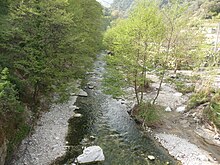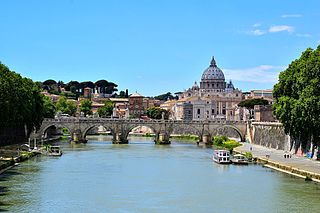
The Tiber is the third-longest river in Italy and the longest in Central Italy, rising in the Apennine Mountains in Emilia-Romagna and flowing 406 km (252 mi) through Tuscany, Umbria, and Lazio, where it is joined by the River Aniene, to the Tyrrhenian Sea, between Ostia and Fiumicino. It drains a basin estimated at 17,375 km2 (6,709 sq mi). The river has achieved lasting fame as the main watercourse of the city of Rome, which was founded on its eastern banks.

Pazzano is a village and comune located in Locride's region in the province of Reggio Calabria.

Stilo is a town and comune in the province of Reggio Calabria, in the Calabria region of southern Italy. It is 151 kilometres (94 mi) from Reggio.
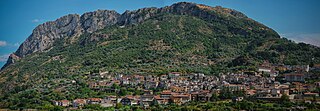
Bivongi is a comune (municipality) in the Province of Reggio Calabria in the Italian region Calabria, located about 50 kilometres (31 mi) southwest of Catanzaro and about 80 kilometres (50 mi) northeast of Reggio Calabria in the Stilaro Valley, at the feet of the Monte Consolino.
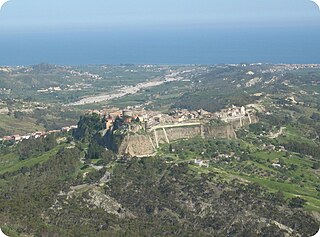
Caulonia is a comune (municipality) in the Province of Reggio Calabria in the Italian region Calabria, located about 60 kilometres (37 mi) southwest of Catanzaro and about 120 kilometres (75 mi) northeast of Reggio Calabria in the Stilaro Valley. Originally it was known as Castelvetere, but in 1862 the citizens decided to change the name of the town to that of the ancient city Caulonia. They believed that this city had been located on their territory, but it was eventually proved that ancient Caulonia was to be found near modern Monasterace, 16 kilometres (10 mi) to the northeast.

Monasterace is a comune (municipality) in the Province of Reggio Calabria in the Italian region Calabria, located about 50 kilometres (31 mi) south of Catanzaro and about 90 kilometres (56 mi) northeast of Reggio Calabria. The ruins of the ancient Greek city Caulonia are located a short distance north of the frazione Monasterace Marina, on the coast. Also north of Monasterace Marina is the Monasterace Archeological Museum, where finds from Caulonia are exhibited.

Placanica is a comune in the Province of Reggio Calabria in the Italian region Calabria, located about 60 kilometres (37 mi) south of Catanzaro and about 80 kilometres (50 mi) northeast of Reggio Calabria. Placanica borders the following communes: Caulonia, Pazzano, Stignano.

Riace is a comune (municipality) in the Metropolitan City of Reggio Calabria in the Italian region Calabria, located about 50 kilometres (31 mi) south of Catanzaro and about 80 kilometres (50 mi) northeast of Reggio Calabria. Riace borders the municipalities of Camini and Stignano.

The Scrivia, 117 kilometres (73 mi) long, is a right tributary of the river Po, in northern Italy. It runs through Liguria, Piedmont, and Lombardy.

The Crati is a river in Calabria, southern Italy. It is the largest river of Calabria and the third largest river of southern Italy after the Volturno and the Sele. In classical antiquity it was known as the Crathis or Crater.
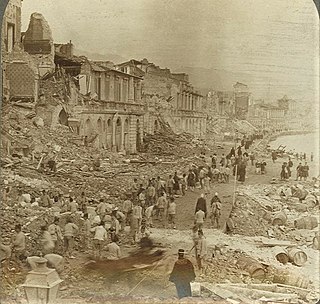
The 1908 Messina earthquake occurred on 28 December in Sicily and Calabria, southern Italy with a moment magnitude of 7.1 and a maximum Mercalli intensity of XI (Extreme). The epicentre was in the Strait of Messina which separates Sicily from the Italian mainland. The cities of Messina and Reggio Calabria were almost completely destroyed and between 75,000 and 82,000 people died. It was the most destructive earthquake ever to strike Europe.
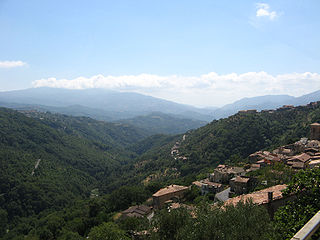
The Savuto is a river and valley in Calabria, Southern Italy, that lies at the intersection of the provinces of Cosenza and Catanzaro. It is also the name of a DOC wine produced in the region.

The Vallata dello Stilaro is a valley in the Province of Reggio Calabria of Southern Italy. It takes its name from river that flow in the area, the Stilaro.

The Ecomuseo delle ferriere e fonderie di Calabria is an ecomuseum in Bivongi, Calabria, southern Italy.
Locride is an area of Calabria, Italy around the town of Locri in the Province of Reggio Calabria. The term takes origin from the Locris, an ancient Greek region.

The Allaro is a river in Calabria, Southern Italy. It flows into the Ionian Sea at Marina di Caulonia. It gives its name to the valley through which it runs and is a candidate for the site of the ancient river Sagra.
Mantonico bianco is a white Italian wine grape variety grown in the Calabria wine region of southern Italy. The grape should not be confused with the similarly named Calabrian grape Montonico bianco or with Guardavalle, which is known as Mantonico in the province of Cosenza in Calabria. In the early 21st century, DNA profiling suggested that Mantonico bianco may be one of the parent varieties of the red Calabrian grape Gaglioppo which is also known as Mantonico nero.
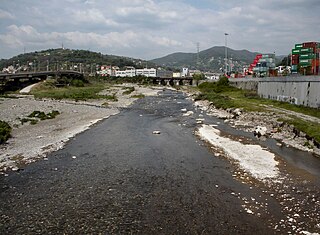
The Polcevera is a 19-kilometre (12 mi) river in Liguria (Italy).

The Neto is a river in Calabria, southern Italy. It is the second largest river of Calabria after the Crati.

The Esaro is a river in the province of Crotone, Calabria, southern Italy. Its source is near Cutro. The river flows southeast near Crotone Airport before curving northeast and eventually flowing into the Ionian Sea just north of Crotone.


